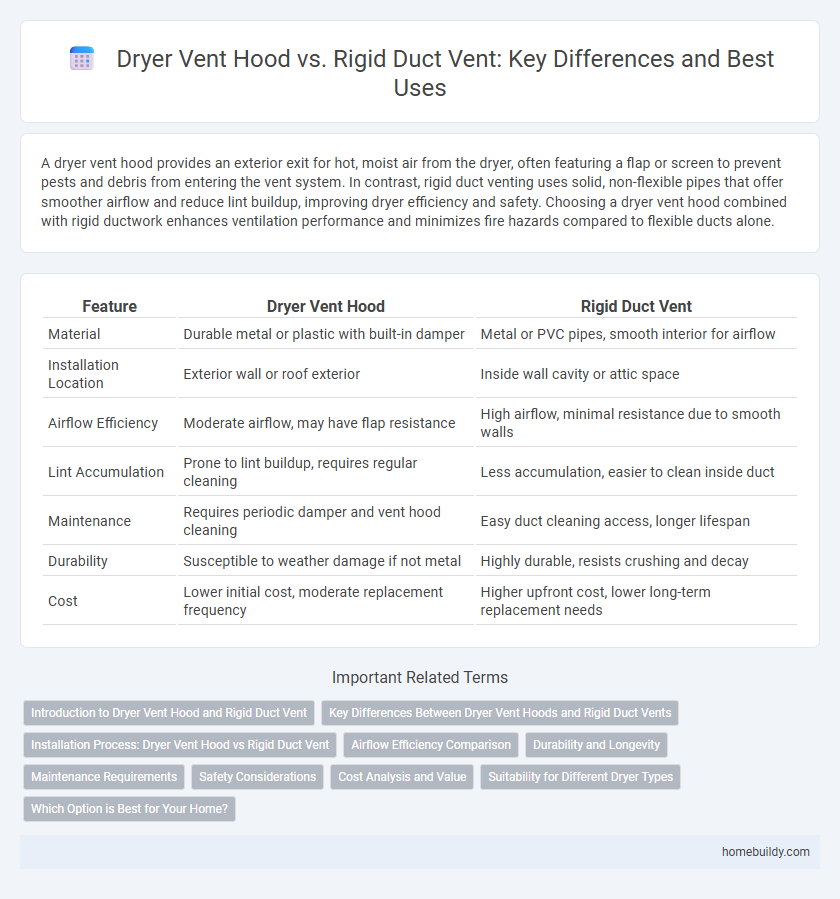A dryer vent hood provides an exterior exit for hot, moist air from the dryer, often featuring a flap or screen to prevent pests and debris from entering the vent system. In contrast, rigid duct venting uses solid, non-flexible pipes that offer smoother airflow and reduce lint buildup, improving dryer efficiency and safety. Choosing a dryer vent hood combined with rigid ductwork enhances ventilation performance and minimizes fire hazards compared to flexible ducts alone.
Table of Comparison
| Feature | Dryer Vent Hood | Rigid Duct Vent |
|---|---|---|
| Material | Durable metal or plastic with built-in damper | Metal or PVC pipes, smooth interior for airflow |
| Installation Location | Exterior wall or roof exterior | Inside wall cavity or attic space |
| Airflow Efficiency | Moderate airflow, may have flap resistance | High airflow, minimal resistance due to smooth walls |
| Lint Accumulation | Prone to lint buildup, requires regular cleaning | Less accumulation, easier to clean inside duct |
| Maintenance | Requires periodic damper and vent hood cleaning | Easy duct cleaning access, longer lifespan |
| Durability | Susceptible to weather damage if not metal | Highly durable, resists crushing and decay |
| Cost | Lower initial cost, moderate replacement frequency | Higher upfront cost, lower long-term replacement needs |
Introduction to Dryer Vent Hood and Rigid Duct Vent
Dryer vent hoods are exterior components designed to protect and efficiently expel moist air from clothes dryers, typically featuring a flap or grille to prevent debris and pests from entering. Rigid duct vents, constructed from durable metal materials like aluminum or galvanized steel, provide a smooth, non-porous pathway that minimizes lint accumulation and airflow obstruction. Combining a quality dryer vent hood with rigid duct venting ensures optimal dryer performance, enhanced safety, and reduced fire hazards.
Key Differences Between Dryer Vent Hoods and Rigid Duct Vents
Dryer vent hoods are external fixtures designed to release hot, moist air from the dryer to the outside, preventing lint buildup and moisture problems. Rigid duct vents are internal components made from metal, providing a straight, durable pathway for airflow from the dryer to the vent hood, reducing the risk of lint accumulation and fire hazards. The primary difference lies in their function: dryer vent hoods serve as the final exhaust point outside the building, while rigid duct vents act as conduits within the home's ventilation system.
Installation Process: Dryer Vent Hood vs Rigid Duct Vent
Dryer vent hoods typically feature a straightforward installation involving mounting the hood directly to the exterior wall, ensuring proper alignment for efficient airflow. In contrast, rigid duct vents require precise measurements, cutting, and sealing to securely connect rigid metal ductwork, which can be more labor-intensive and time-consuming. Proper installation of both options is critical to prevent lint buildup and ensure optimal dryer performance and safety.
Airflow Efficiency Comparison
Dryer vent hoods typically offer better airflow efficiency compared to rigid duct vents due to their streamlined design that minimizes bends and obstructions. Rigid duct vents, often constructed from metal, can experience airflow resistance at joints and bends, reducing overall drying performance and increasing energy consumption. Efficient airflow through vent hoods lowers lint buildup and drying time, enhancing safety and dryer lifespan.
Durability and Longevity
Dryer vent hoods made from durable materials like stainless steel or aluminum offer superior resistance to weather damage and corrosion compared to rigid duct vents typically constructed from galvanized steel or plastic. Their enhanced structural integrity prevents cracks and breaks, ensuring consistent airflow and reducing maintenance over time. This durability directly translates into longer service life and more reliable performance in venting exhaust efficiently.
Maintenance Requirements
Dryer vent hoods typically require less frequent maintenance compared to rigid duct vents because their simpler design minimizes lint buildup and reduces the risk of obstructions. Rigid duct vents, while durable, often need regular cleaning to prevent lint accumulation within their longer and more complex ductwork, which can lead to decreased dryer efficiency and potential fire hazards. Ensuring consistent inspection and cleaning schedules for both systems is crucial to maintain optimal ventilation performance and safety.
Safety Considerations
Dryer vent hoods and rigid duct vents each present unique safety considerations crucial for preventing fire hazards and ensuring proper airflow. Rigid duct vents, typically made of metal, reduce the risk of lint buildup and overheating compared to flexible vents, enhancing fire safety. Dryer vent hoods with proper backdraft dampers prevent pest intrusion and moisture buildup, which can cause mold growth and system inefficiency.
Cost Analysis and Value
Dryers vent hoods generally offer a lower initial cost compared to rigid duct vents, making them a budget-friendly option for homeowners. While rigid duct vents present higher upfront expenses due to material and installation, they provide enhanced durability and better airflow efficiency, which can reduce energy costs over time. Evaluating long-term value, rigid duct vents often yield greater cost savings by minimizing lint buildup and maintenance needs, potentially offsetting their initial price difference.
Suitability for Different Dryer Types
Dryer vent hoods are ideal for electric dryers due to their ease of installation and compatibility with standard venting requirements, while rigid duct vents provide a more durable and fire-resistant option suited for gas dryers that require safe exhaust of combustion gases. Rigid ducts minimize lint accumulation and improve airflow efficiency, making them a preferred choice for high-capacity or long-duct installations. Selecting the appropriate venting system based on dryer type enhances safety, performance, and energy efficiency in laundry setups.
Which Option is Best for Your Home?
A dryer vent hood offers superior protection against pests and weather elements, making it ideal for exterior venting with easy maintenance. Rigid duct vents provide more durability and smoother airflow, reducing lint buildup and improving dryer efficiency inside the home's duct system. Choosing between a dryer vent hood and a rigid duct vent depends on your home's layout, venting distance, and need for long-term vent reliability.
Dryer vent hood vs rigid duct vent Infographic

 homebuildy.com
homebuildy.com